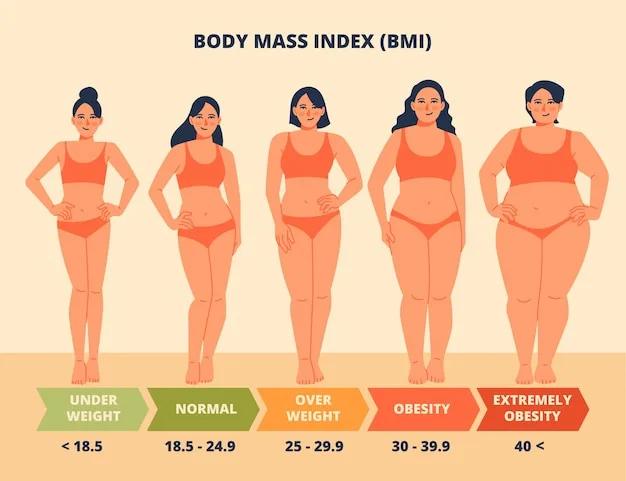Class 3 obesity is a chronic disease that describes what used to be known as morbid obesity or severe obesity. It is a complex condition that raises the risk of serious health problems. People with class III obesity have a body mass index (BMI) of 40 or above.
📝 What is BMI?
One method of classifying obesity used by healthcare professionals is a screening tool called Body Mass Index. BMI is a measure of your body fat, based on your height and weight.
BMI is widely used as a tool to measure if you are overweight or have obesity, due to its simplicity and cost-effectiveness. By using a person’s weight and height measurement, BMI provides a quick estimation of body fat percentage. A BMI chart is used to categorize a person as underweight, healthy weight, overweight, Class1 obesity, Class 2 obesity or Class 3 obesity.
NICE guidelines (National Institute for Health and Care Excellence) points out BMI is a practical measure, but should be used with caution because it is not a direct measure of central adiposity (accumulation of fat around the tummy area). Central adiposity plays a significant role in the development of cardiovascular diseases (CVD), type 2 diabetes and metabolic syndrome.
📈 Obesity levels based on BMI
Increasing BMI levels typically have increasingly higher levels of health consequences. The Centers for Disease Control and Prevention define BMI ranges as:
- Overweight: BMI 25-30kg/m² (not obese)
- Class I Obesity: BMI 30-35kg/m² (low risk)
- Class II Obesity: BMI 35-40 kg/m² (moderate risk)
- Class III Obesity: BMI ≥ 40.0 kg/m² (high risk)
The different classes of obesity are based on severity. Class 1 is the least severe class, while class 3 is the most severe.
The above obesity classes are general guidelines that healthcare providers use when assessing obesity, but the BMI scale isn’t always accurate for certain populations or ethnicities. For example, research into health complications has shown that Asian populations are more likely to have a higher amount of body fat at a lower BMI, and therefore, lower BMI cut-off values are commonly used for these populations. Some healthcare providers may also recommend measuring waist circumferences. This measurement may be more helpful in determining risk of health problems in people from different backgrounds.
📈 Class 3 obesity
Class 3 obesity is the least common but most severe and can affect your overall health and quality of life.
Health risks of Class III obesity
Carrying excess weight increases the prevalence of developing additional health conditions (comorbidities) such as fatty liver disease, kidney disease, gallbladder disease, sleep apnea, osteoarthritis and stroke. Additionally, having a BMI above the healthy range has been shown to impact mental health and a lower quality of life.
Cardiovascular disease
High blood pressure (hypertension), cholesterol, and triglycerides are all linked to cardiovascular disease. When these levels are elevated in the body over a long period, they can lead to plaque build up in the arteries, which restricts blood flow and increases the risk of heart attack or stroke. In addition, obesity can have a significant impact on heart function as excess weight puts stress on the heart and contributes to conditions such as coronary artery disease (CAD), one of the most common complications associated with cardiovascular disease.
A lower life expectancy
Individuals’ with class 3 obesity can have a reduced life expectancy, from anywhere between 6 and 14 years, depending on how old they are, their gender and other health conditions they are experiencing. The higher their BMI, the more risk they are at for dying prematurely from a heart attack, stroke, or other obesity-related condition. Individuals with class 3 obesity can improve their life expectancy significantly if they lose weight.
Type 2 Diabetes
Obesity is a known risk factor for type 2 diabetes due to its link between excess body fat and insulin resistance. When overweight individuals gain weight, their bodies require more insulin to regulate blood sugar levels, leading to decreased sensitivity and eventual resistance. This can result in high blood sugar levels, which over time can lead to type 2 diabetes.
Joint problems
Carrying excess weight puts extra pressure on joints and as a result joint problems are more likely to occur in people with a high BMI. Osteoarthritis is a common issue for those carrying extra pounds, especially in their knees. Losing even just 5-10% of body weight can significantly reduce the chances of developing joint problems.
Joint pain caused by being overweight or obese can also make exercise difficult, which further contributes to health risks such as heart disease and stroke. It’s important to take steps towards losing weight if you have a high BMI to reduce your risk of joint problems and other associated health issues.
Sleep apnea
Individuals with a high BMI need to be aware of their greater risk for obstructive sleep apnea (OSA) and other associated health conditions. OSA is a serious medical condition that affects breathing during sleep. It occurs when there are repeated episodes of complete or partial blockage in the upper airway, leading to interrupted breathing patterns. This can result in symptoms such as loud snoring and daytime fatigue.
Risk factors
Certain factors put us at increased risk of developing Class 3 obesity or any class of obesity, theses include:
- Poor dietary habits and lack of physical activity, affecting a person’s levels of energy
- Socioeconomic conditions can limit access to fresh food and the ability to exercise
- Genetic factors may predispose a person to obesity
- Family history may contribute through both genetic and environmental factors
- Some medical conditions have links with obesity, including Cushing’s syndrome and polycystic ovary syndrome
- Stress and anxiety can increase levels of the hormone cortisol, which can affect fat storage and weight gain
- A lack of sleep may contribute
💊 What are the treatment options for obesity?
Weight loss medications
Commonly prescribed anti-obesity medications include:
- Orlistat
- Phentermine
- Phentermine-Topiramate
- Naltrexone-Bupropion
- Liraglutide
- Semaglutide
- Tirzepatide
These medications each have different side effects. Together, you and your provider will decide if weight loss medications are right for you.
Weight loss surgery
Bariatric surgery procedures work by changing your digestive system. Usually your stomach and sometimes also your small intestine, to regulate how many calories you can consume and absorb. They can also reduce the hunger signals that travel from your digestive system to your brain. Bariatric surgeries include:
- Duodenal switch
- Gastric band (LAP band)
- Gastric bypass (Roux-en-Y)
- Gastric sleeve (sleeve gastrectomy)
Lifestyle changes
Adjust the energy balance
Maintaining a healthy body weight requires a balance between energy intake (calories consumed) and energy expenditure (calories burned). When energy intake and expenditure are equal, weight remains stable. Consuming more calories than the body needs leads to weight gain while consuming fewer calories than burned results in weight loss.
To achieve energy balance and maintain a healthy weight, it is essential to:
- Follow a healthy and balanced diet, rich in nutrients and low in empty calories
- Reduce daily calorie/food intake to promote weight loss
- Engage in regular physical activity to increase energy expenditure
- Limit sedentary behaviours and incorporate more movement throughout the day
Healthy eating
A nutritious healthy diet plays a crucial role in achieving and maintaining a healthy weight range. It is important to focus on:
- Eating a variety of nutrient-dense foods, including fruits, vegetables, whole grains, lean proteins, and healthy fats
- Choosing foods low in added sugars, saturated fats, and sodium
- Smaller portion control to avoid overeating
- Listening to hunger and fullness cues to eat mindfully
- Planning meals ahead of time to make healthier choices
By adopting these healthy eating habits, individuals can nourish their bodies while managing their weight effectively.
Regular physical activity
Physical activity is an integral part of a healthy lifestyle and weight management. It not only helps burn calories but also improves cardiovascular health, strengthens muscles, and boosts overall well-being. To incorporate more physical activity into your daily routine:
- Engage in moderate-intensity aerobic exercises, such as brisk walking, cycling, or swimming, for at least 150 minutes per week
- Include strength training exercises at least two days a week to build and maintain muscle mass
- Find activities you enjoy and make them a regular part of your routine
- Stay active throughout the day by taking the stairs, walking instead of driving for short distances, or participating in active hobbies
By making physical activity a priority, individuals can improve their fitness levels and achieve a healthy weight.
📝 Conclusion
Class 3 obesity or severe obesity can increase the risk of metabolic syndromes (a group of conditions that increases your risk of heart disease, stroke, and diabetes) some of which can be life threatening.
Anyone with concerns about obesity or its possible symptoms should receive medical advice. Treatments can enable a person to adjust their weight and may help prevent potentially serious complications.
Sources
- Adult BMI Categories | BMI | CDC
- Association between Class III Obesity (BMI of 40–59 kg/m2) and Mortality: A Pooled Analysis of 20 Prospective Studies – PMC
- Class III Obesity (Formerly Known as Morbid Obesity)
- Identification and classification | Diagnosis | Obesity | CKS | NICE
Medical Disclaimer
NowPatient has taken all reasonable steps to ensure that all material is factually accurate, complete, and current. However, the knowledge and experience of a qualified healthcare professional should always be sought after instead of using the information on this page. Before taking any drug, you should always speak to your doctor or another qualified healthcare provider.
The information provided here about medications is subject to change and is not meant to include all uses, precautions, warnings, directions, drug interactions, allergic reactions, or negative effects. The absence of warnings or other information for a particular medication does not imply that the medication or medication combination is appropriate for all patients or for all possible purposes.








